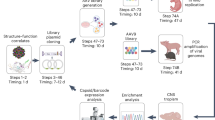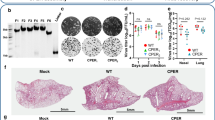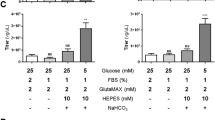Abstract
As an initial assessment of the feasibility of employing the adenovirus serotype 3 (Ad3) fiber knob as a locale for introducing a tropism-modifying motif, we generated an adenoviral vector containing a six-histidine tag genetically fused to the carboxy-terminus of the Ad3 fiber knob. The heterologous tag proved to be accessible for binding in the context of the virion and, moreover, had rendered the modified vector capable of mediating gene transfer through an artificial, non-Ad3 receptor.
This is a preview of subscription content, access via your institution
Access options
Subscribe to this journal
Receive 12 print issues and online access
$259.00 per year
only $21.58 per issue
Buy this article
- Purchase on Springer Link
- Instant access to full article PDF
Prices may be subject to local taxes which are calculated during checkout




Similar content being viewed by others
References
Curiel DT . Strategies to adapt adenoviral vectors for targeted delivery. Ann NY Acad Sci. 1999;886:158–171.
Krasnykh VN, Douglas JT, van Beusechem VW . Genetic targeting of adenoviral vectors. Mol Ther. 2000;1:391–405.
Michael SI, Hong JS, Curiel DT, Engler JA . Addition of a short peptide ligand to the adenovirus fiber protein. Gene Ther. 1995;2:660–668.
Wickham TJ, Roelvink PW, Brough DE, Kovesdi I . Adenovirus targeted to heparan-containing receptors increases its gene delivery efficiency to multiple cell types. Nat Biotechnol. 1996;14:1570–1573.
Wickham TJ, Tzeng E, Shears LL II, et al. Increased in vitro and in vivo gene transfer by adenovirus vectors containing chimeric fiber proteins. J Virol. 1997;71:8221–8229.
Yoshida Y, Sadata A, Zhang W, Saito K, Shinoura N, Hamada H . Generation of fiber-mutant recombinant adenoviruses for gene therapy of malignant glioma. Hum Gene Ther. 1998;9:2503–2515.
Dmitriev I, Krasnykh V, Miller CR, et al. An adenovirus vector with genetically modified fibers demonstrates expanded tropism via utilization of a coxsackievirus and adenovirus receptor-independent cell entry mechanism. J Virol. 1998;72:9706–9713.
Krasnykh V, Dmitriev I, Mikheeva G, Miller CR, Belousova N, Curiel DT . Characterization of an adenovirus vector containing a heterologous peptide epitope in the HI loop of the fiber knob. J Virol. 1998;72:1844–1852.
Xia H, Anderson B, Mao Q, Davidson BL . Recombinant human adenovirus: targeting to the human transferrin receptor improves gene transfer to brain microcapillary endothelium. J Virol. 2000;74:11359–11366.
Gall J, Kass-Eisler A, Leinwand L, Falck-Pedersen E . Adenovirus type 5 and 7 capsid chimera: fiber replacement alters receptor tropism without affecting primary immune neutralization epitopes. J Virol. 1996;70:2116–2123.
Krasnykh VN, Mikheeva GV, Douglas JT, Curiel DT . Generation of recombinant adenovirus vectors with modified fibers for altering viral tropism. J Virol. 1996;70:6839–6846.
Shayakhrnetov DM, Papayannopoulou T, Stamatoyannopoulos G, Lieber A . Efficient gene transfer into human CD34(+) cells by a retargeted adenovirus vector. J Virol. 2000;74:2567–2583.
Stevenson SC, Rollence M, Marshall-Neff J, McClelland A . Selective targeting of human cells by a chimeric adenovirus vector containing a modified fiber protein. J Virol. 1997;71:4782–4790.
Zabner J, Chillon M, Grunst T, et al. A chimeric type 2 adenovirus vector with a type 17 fiber enhances gene transfer to human airway epithelia. J Virol. 1999;73:8689–8695.
Kanerva A, Mikheeva GV, Krasnykh V, et al. Targeting adenovirus to the serotype 3 receptor increases gene transfer efficiency to ovarian cancer cells. Clin Cancer Res. 2002;8:275–280.
Alemany R, Curiel DT . CAR-binding ablation does not change biodistribution and toxicity of adenoviral vectors. Gene Ther. 2001;8:1347–1353.
Kirby I, Davidson E, Beavil AJ, et al. Mutations in the DG loop of adenovirus type 5 fiber knob protein abolish high-affinity binding to its cellular receptor CAR. J Virol. 1999;73:9508–9514.
Roelvink PW, Mi Lee G, Einfeld DA, Kovesdi I, Wickham TJ . Identification of a conserved receptor-binding site on the fiber proteins of CAR-recognizing adenoviridae. Science. 1999;286:1568–1571.
Seki T, Dmitriev I, Kashentseva E, et al. Artificial extension of the adenovirus fiber shaft inhibits infectivity in coxsackievirus and adenovirus receptor–positive cell lines. J Virol. 2002;76:1100–1108.
Chartier C, Degryse E, Gantzer M, Dieterle A, Pavirani A, Mehtali M . Efficient generation of recombinant adenovirus vectors by homologous recombination in Escherichia coli. J Virol. 1996;70:4805–4810.
Maizel N Jr, White DO, Scharff MD . The polypeptides of adenovirus: I. Evidence for multiple protein components in the virion and a comparison of types 2, 7A, and 12. Virology. 1968;36:115–125.
Douglas JT, Miller CR, Kim M, et al. A system for the propagation of adenoviral vectors with genetically modified receptor specificities. Nat Biotechnol. 1999;17:470–475.
Lindner P, Bauer K, Krebber A, et al. Specific detection of his-tagged proteins with recombinant anti–His tag scFv-phosphatase or scFv-phage fusions. Biotechniques. 1997;22:140–149.
Acknowledgements
We thank the CFAR DNA Sequencing Core at the University of Alabama at Birmingham. V N Krasnykh is thanked for providing the plasmid pNEB.PK.F5/3. This work was supported by the Dutch Cancer Society, Bekker-la-Bastide fonds, Schuurman-Shimmel van Outeren Stichting, Dittmerfonds, Stichting Korinthiers, the Juvenile Diabetes Foundation (JDF-I-2000-23), and the National Institutes of Health (N01 CO-97110, P50 CA89019, R01 HL67962, R01 CA68245, R01 CA74242, R01 CA86881, R03 CA9054 7, and U19 DK57858).
Author information
Authors and Affiliations
Corresponding author
Rights and permissions
About this article
Cite this article
Uil, T., Seki, T., Dmitriev, I. et al. Generation of an adenoviral vector containing an addition of a heterologous ligand to the serotype 3 fiber knob. Cancer Gene Ther 10, 121–124 (2003). https://doi.org/10.1038/sj.cgt.7700543
Received:
Published:
Issue Date:
DOI: https://doi.org/10.1038/sj.cgt.7700543
Keywords
This article is cited by
-
Complex mosaicism is a novel approach to infectivity enhancement of adenovirus type 5-based vectors
Cancer Gene Therapy (2005)



